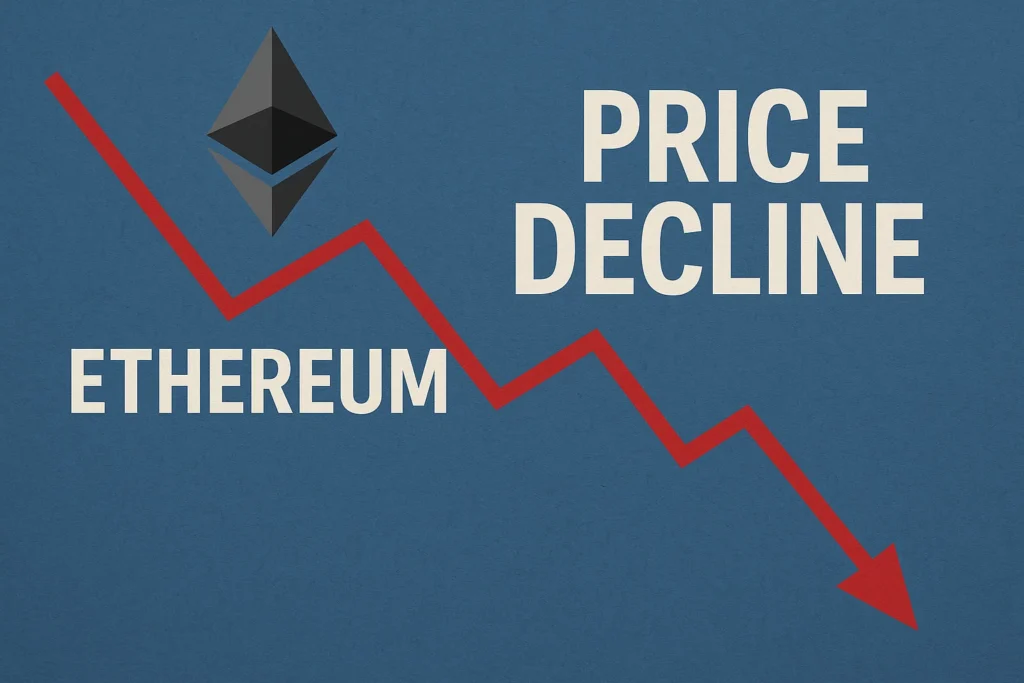Ethereum price decline is taking center stage as investors grow increasingly concerned about the second-largest cryptocurrency’s trajectory. As ETH slips lower against both Bitcoin and the US Dollar, market participants are questioning whether this downward momentum will accelerate into more substantial double-digit losses.
Ethereum’s recent price decline has caught many investors off guard, particularly given the network’s strong fundamentals and ongoing technological developments. The current market sentiment reflects broader concerns about cryptocurrency adoption, regulatory pressures, and macroeconomic factors that continue to influence digital asset valuations across the board.
Understanding the factors driving this Ethereum price decline requires a comprehensive analysis of both technical indicators and fundamental market dynamics that have shaped the cryptocurrency landscape in recent months.
Current Market Analysis of Ethereum’s Performance
Technical Indicators Signal Continued Weakness
The Ethereum price decline has been accompanied by several concerning technical indicators that suggest further downside potential. Trading volume has increased significantly during recent selling sessions, indicating that institutional and retail investors alike are positioning themselves for extended market weakness.
Key resistance levels that previously provided support have now become overhead resistance, creating additional selling pressure whenever the ETH price attempts to recover. The relative strength index (RSI) has entered oversold territory multiple times, yet each subsequent bounce has failed to generate sustainable upward momentum.
Moving averages across multiple timeframes have turned bearish, with the 50-day moving average crossing below the 200-day moving average – a technical pattern known as a “death cross” that often signals extended periods of downturn in the cryptocurrency market.
Support Levels Under Pressure
Critical support zones that have historically held during previous market corrections are now being tested. The psychological $1,500 level has been particularly significant, as a break below this threshold could accelerate the Ethereum price decline toward the next central support region around $1,200.
Market makers and algorithmic trading systems have concentrated significant sell orders at these key levels, creating additional downward pressure during periods of high volatility. This dynamic has made it increasingly difficult for buyers to establish meaningful positions without facing immediate selling pressure.
Fundamental Factors Contributing to ETH’s Weakness
Regulatory Uncertainty Impact
The Ethereum price decline has been exacerbated by ongoing regulatory uncertainty surrounding blockchain technology and the classification of cryptocurrencies. Recent statements from financial regulators in major markets have raised additional concerns about the long-term regulatory framework governing digital assets.
Innovative contract platforms, such as Ethereum, face particular scrutiny due to their role in facilitating decentralized finance (DeFi) applications and non-fungible token (NFT) marketplaces. This regulatory overhang has contributed to reduced institutional investment flows and increased selling pressure from risk-averse market participants.
Network Competition Intensifies

Competition from alternative innovative contract platforms has intensified significantly, with several blockchain networks offering faster transaction speeds and lower fees than Ethereum. This competitive pressure has raised questions about Ethereum’s long-term market dominance and contributed to the current decline in the ETH price.
Layer-2 scaling solutions and interoperability protocols have provided users with more options for executing smart contracts and DeFi transactions, reducing the exclusive demand for Ethereum’s network capacity. While these developments benefit the broader cryptocurrency ecosystem, they have created headwinds for ETH price appreciation.
Market Sentiment and Investor Behavior
Institutional Investment Patterns
Large-scale investors have shown increased caution regarding Ethereum exposure, with several prominent cryptocurrency funds reducing their ETH allocations in favor of more defensive positions. This shift in institutional sentiment has significantly contributed to the ongoing decline in Ethereum’s price.
Hedge funds and family offices that previously viewed Ethereum as a core holding have begun diversifying into other digital assets or reducing their overall cryptocurrency exposure. This trend has been particularly pronounced among institutions with shorter investment horizons and stricter risk management requirements.
Retail Investor Capitulation
Retail investors, who represent a significant portion of Ethereum’s trading volume, have shown signs of capitulation as the price decline has persisted. Social media sentiment indicators and cryptocurrency discussion forums reflect increased pessimism about ETH’s near-term prospects.
The fear and greed index for cryptocurrencies has reached extreme fear levels, historically indicating that markets may be approaching oversold conditions. However, previous instances of extreme fear have sometimes preceded additional selling pressure before meaningful bottoms are established.
Technical Analysis: Double-Digit Loss Potential
Chart Pattern Recognition
Current Ethereum price charts display several bearish patterns, suggesting potential for continued weakness. A descending triangle formation has developed over recent weeks, characterized by declining highs and relatively stable lows, creating a narrowing price range that typically resolves to the downside.
The breakdown below key support levels has triggered additional technical selling, as stop-loss orders and algorithmic trading systems execute predetermined exit strategies. This mechanical selling pressure often accelerates price declines beyond what is justified by fundamentals.
Volume Analysis Confirms Weakness
Trading volume patterns during the Ethereum price decline have shown characteristics typical of distribution phases, where large holders gradually reduce their positions. Higher volume during down days compared to up days suggests that selling pressure remains dominant.
Volume profile analysis suggests that significant trading activity has occurred at higher price levels, resulting in a concentration of investors who are currently holding unrealized losses. This overhead supply represents potential selling pressure during any recovery attempts.
Broader Cryptocurrency Market Context
Correlation with Traditional Markets
The Ethereum price decline has coincided with increased correlation between cryptocurrencies and traditional risk assets, particularly technology stocks. This correlation has exposed digital assets to broader macroeconomic pressures, including concerns about inflation, interest rate policies, and geopolitical tensions.
When traditional markets experience volatility, cryptocurrencies have increasingly moved in tandem, reducing their effectiveness as portfolio diversification tools. This dynamic has contributed to reduced institutional interest and increased selling pressure during periods of market stress.
Bitcoin’s Influence on Alt-Coin Performance
Bitcoin’s price action continues to influence the broader cryptocurrency market, including Ethereum. When Bitcoin experiences significant selling pressure, alternative cryptocurrencies typically face amplified downside moves, a phenomenon known as the “alt-coin bleed.”
The BTC/ETH trading pair has shown relative weakness for Ethereum, indicating that even within the cryptocurrency ecosystem, investors are showing a preference for Bitcoin’s perceived safety and liquidity advantages.
Potential Scenarios for Ethereum’s Future
Bear Case: Extended Decline Scenario
If the Ethereum price decline continues, several factors could contribute to more substantial losses. Increased regulatory pressure, continued competition from alternative blockchain platforms, and macroeconomic headwinds could significantly lower ETH prices.
In this scenario, Ethereum could potentially test support levels not seen since the previous major market cycle, with double-digit percentage losses extending over several months. Such a decline would likely trigger additional capitulation from both retail and institutional investors.
Bull Case: Recovery Potential
Despite current weakness, Ethereum maintains strong fundamental characteristics that could support eventual recovery. Network usage remains robust, with DeFi applications and smart contracts continuing to generate significant transaction fees and network activity.
Upcoming technological upgrades and improvements to the Ethereum network could restore investor confidence and attract renewed buying interest. Additionally, oversold technical conditions may eventually attract value-oriented investors seeking long-term exposure to blockchain technology.
Risk Management Strategies for Investors
Position Sizing Considerations
Given the volatility and uncertainty surrounding Ethereum’s price, appropriate position sizing becomes crucial for investors maintaining exposure to digital assets. Risk management principles suggest limiting cryptocurrency exposure to amounts that investors can afford to lose without significant financial impact.
Dollar-cost averaging strategies may help reduce the impact of timing decisions, allowing investors to accumulate Ethereum positions gradually as prices potentially reach more attractive levels. However, this approach requires a firm conviction in Ethereum’s long-term prospects.
Diversification Within Digital Assets
The cryptocurrency market offers various alternatives that may provide different risk-return profiles during periods of Ethereum weakness. However, high correlations between major cryptocurrencies limit the diversification benefits within the digital asset space.
Some investors have explored exposure to blockchain technology through equity investments in companies developing cryptocurrency infrastructure, mining operations, or related financial services. These alternatives may provide indirect exposure while potentially offering different risk characteristics.
Industry Expert Perspectives
Analyst Opinions Vary

Cryptocurrency analysts have expressed mixed opinions regarding the decline in Ethereum’s price and its potential duration. Some technical analysts point to historical patterns that suggest oversold conditions may lead to eventual recovery, while others emphasize the significance of recent support level breakdowns.
Fundamental analysts often focus on Ethereum’s network metrics, including transaction volumes, developer activity, and the growth of its decentralized finance (DeFi) ecosystem. These metrics have demonstrated resilience despite price weakness, suggesting that the underlying network value may not be fully reflected in the current market pessimism.
Market Maker Perspectives
Professional market makers and cryptocurrency trading firms have observed increased volatility and reduced liquidity during the decline in Ethereum prices. These conditions create both challenges and opportunities for active traders, but may contribute to amplified price movements in both directions.
The options market for Ethereum has exhibited increased implied volatility, suggesting that market participants anticipate continued price uncertainty. This elevated volatility premium reflects the challenge of accurately predicting short-term price movements in the current environment.
Long-Term Outlook for Ethereum
Technological Development Pipeline
Despite current price weakness, Ethereum’s development roadmap includes several significant upgrades that could impact long-term network adoption and value proposition. These technological improvements address scalability, security, and energy efficiency concerns that have historically limited Ethereum’s mainstream adoption.
The transition to proof-of-stake consensus and ongoing work on sharding solutions represent fundamental improvements to Ethereum’s infrastructure. While these developments may take time to implement and fully demonstrate their benefits, they provide a solid foundation for future growth potential.
Ecosystem Growth Metrics
Ethereum’s ecosystem continues to expand, despite current market conditions, with new decentralized applications launching regularly and existing protocols continually innovating. The total value locked in DeFi protocols, while subject to price fluctuations, represents significant economic activity built on Ethereum’s infrastructure.
Non-fungible token marketplaces, decentralized exchanges, and lending protocols continue to generate substantial transaction fees for the Ethereum network. This economic activity provides fundamental support for ETH’s long-term value proposition, regardless of short-term price movements.
Conclusion
The current decline in the Ethereum price represents a significant challenge for investors and supporters of the world’s second-largest cryptocurrency. While technical indicators suggest the potential for continued weakness and possible double-digit losses, the fundamental strength of Ethereum’s network and ecosystem provides reasons for cautious optimism among long-term believers.
Market participants must carefully weigh the risks and opportunities presented by the current environment. The cryptocurrency market’s inherent volatility means that significant price movements in both directions remain possible, making risk management and appropriate position sizing essential for any investment strategy.
Read more: Bitcoin News 7% Dip vs $141K Breakout – Market Analysis Btc price


